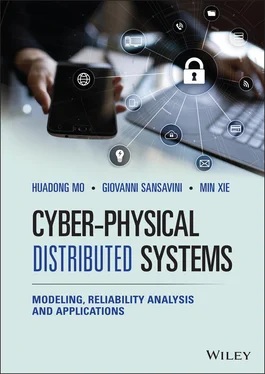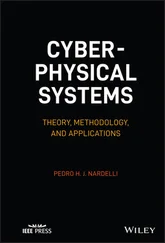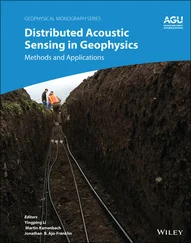Min Xie - Cyber-Physical Distributed Systems
Здесь есть возможность читать онлайн «Min Xie - Cyber-Physical Distributed Systems» — ознакомительный отрывок электронной книги совершенно бесплатно, а после прочтения отрывка купить полную версию. В некоторых случаях можно слушать аудио, скачать через торрент в формате fb2 и присутствует краткое содержание. Жанр: unrecognised, на английском языке. Описание произведения, (предисловие) а так же отзывы посетителей доступны на портале библиотеки ЛибКат.
- Название:Cyber-Physical Distributed Systems
- Автор:
- Жанр:
- Год:неизвестен
- ISBN:нет данных
- Рейтинг книги:3 / 5. Голосов: 1
-
Избранное:Добавить в избранное
- Отзывы:
-
Ваша оценка:
- 60
- 1
- 2
- 3
- 4
- 5
Cyber-Physical Distributed Systems: краткое содержание, описание и аннотация
Предлагаем к чтению аннотацию, описание, краткое содержание или предисловие (зависит от того, что написал сам автор книги «Cyber-Physical Distributed Systems»). Если вы не нашли необходимую информацию о книге — напишите в комментариях, мы постараемся отыскать её.
SYSTEMS
Gather detailed knowledge and insights into cyber-physical systems behaviors from a cutting-edge reference written by leading voices in the field Cyber-Physical Distributed Systems: Modeling, Reliability Analysis and Applications
Cyber-Physical Distributed Systems
Cyber-Physical Distributed Systems
Cyber-Physical Distributed Systems — читать онлайн ознакомительный отрывок
Ниже представлен текст книги, разбитый по страницам. Система сохранения места последней прочитанной страницы, позволяет с удобством читать онлайн бесплатно книгу «Cyber-Physical Distributed Systems», без необходимости каждый раз заново искать на чём Вы остановились. Поставьте закладку, и сможете в любой момент перейти на страницу, на которой закончили чтение.
Интервал:
Закладка:
Chapter 7investigates sequential control problems (i.e., sequential cyberteam deployment) in modern CPSs by introducing an adversarial cost sequence with a variation constraint. Chapter 6reviews the data‐driven vulnerability model, and Chapter 7deals with the dataset of the arrival time of cyberattacks, which uncovers the statistical pattern of attackers. To solve such problems, a fundamental idea is to first obtain sampled parameters for the arrival model of cyberattacks from the posterior distribution of realistic cyberattack arrival records. The reinforcement learning model for estimating parameters is formulated as a partly parameterized Bayesian model. As a result, the sampled parameters are used instead of the true parameters. The paradigm of this framework can also be applied to other classical models, although specific models are used here for illustration purposes. Next, a Bayesian multi‐node bandit is built to cope with the problem, and an online learning algorithm (the Thompson‐Hedge algorithm) is forwarded to retain a converging regret function that is a function of the cyberteam deployment. By comparison with the existing algorithm, the convergence rate of the regret function in the proposed algorithm is found to be superior.
Each of Chapters 3– 7can be read independently when one is interested in a specific type of application or further research, making the book attractive to readers from different areas or positions. This book has the following distinct features:
It is the first book to systematically focus on CPSs with respect to modeling and reliability analysis.
It provides a comprehensive treatment of imperfect fault coverage (single level/multi‐level or modular), functional dependence, common cause failures (deterministic and probabilistic), competing failures (deterministic and probabilistic), and dynamic standby sparing.
It includes abundant illustrative examples and case studies based on real‐world systems.
It covers recent advances in combinatorial models and algorithms for CPS modeling and analysis.
It has a rich set of references, providing helpful resources for readers to pursue further research and study of the topics.
The target audience of the book is undergraduate (senior level) and graduate students, engineers, and researchers in system science and related disciplines, including those in computers, telecommunications, transportation, and other industries. Readers should have some knowledge of basic probability theory, control theory, computer science, optimization, game theory, and stochastic processes. However, the book includes a chapter reviewing the fundamentals that readers need to know for understanding the content of the other chapters covering advanced topics in CPSs and case studies. The book can provide readers with knowledge and insight of CPS behaviors, as well as the skills of modeling and analyzing these behaviors to guide the resilient design of real‐world critical systems. Thus, the book includes necessary background information, making it self‐contained. For some detailed topics, selected for their importance and application potential, references are provided for those interested in further details.
We would like to express our sincere appreciation to the many researchers who have proposed some underlying concepts, frameworks, and methods used in this book, or who have co‐authored with us some topics of the book and provided their insights; to name a few, Professor Enrico Zio from Politecnico di Milano, Professor Yanfu Li from Tsinghua University, Dr. Gregory Levitin from the Israel Electric Corporation, Professor David W. Coit from Rutgers University, and Professor Junlin Xiong from the University of Science and Technology of China. Though there are many other researchers to mention, and we have tried to recognize their significant contributions in the bibliographical references of the book.
Finally, it was our huge pleasure to work with Juliet Booker, managing editor of Electrical & Computer Engineering, John Wiley & Sons Ltd., and her team, who have assisted in the publication of this book. We deeply appreciate their efforts and support.
December 15, 2020
Huadong Mo Min Xie Giovanni Sansavini
Acronyms and Abbreviations
| ACE | Area Control Error |
| AERs | All‐Electric Ranges |
| AGC | Automatic Generation Control |
| AGC' | Actual Global Cost |
| B | Biomass Power |
| BESS | Battery Energy Storage System |
| CBM | Condition‐Based Maintenance |
| CC | Control Center |
| CCC | Centralized Control Centers |
| CCF | Cross‐Correlation Factor |
| CPS | Cyber‐Physical System |
| CSMA/AMP | Carrier Sense Multiple Access with Arbitration on Message Priority |
| CSMA/CD | Carrier Sense Multiple Access with Collision Detection |
| CTMC | Continuous‐Time Markov Chains |
| DC | Direct Current |
| DEG | Diesel Engine Generator |
| DERs | Distributed Energy Resources |
| DG | Distributed Generation |
| DGS | Distributed Generation Systems |
| DHMM | Discrete HMM |
| DoS | Denial of Service |
| DR | Demand Response |
| EENS | Expected ENS |
| EM | Expectation‐Maximization |
| ENS | Energy Not Supplied |
| ERP | Expected RP |
| ESS | Energy Storage System |
| EV | Electrical Vehicle |
| EWMA | Exponentially Weighted Moving Average |
| FDs | Feeders |
| FERC | Federal Energy Regulatory Commission |
| FESS | Flywheel Energy Storage System |
| FFT | Fast Fourier Transform |
| G | Natural Gas Plant |
| GA | Genetic Algorithms |
| GC | Global Cost |
| GM | Grey Differential Model |
| Ls | Loads |
| LAN | Local Area Networks |
| LC | Long‐Run Cost Rate |
| LFC | Load Frequency Control |
| LP | Linear Programming |
| HAN | Home Area Networks |
| HGSAA | Hybrid Genetic‐Simulated‐Annealing Algorithm |
| HMM | Hidden Markov Model |
| HPS | Hybrid Power System |
| MAC | Media Access Control |
| MADT | Maximum Allowable Delay Time |
| MCR | Maintenance Cost Rate |
| MCS | Monte Carlo Simulation |
| MDEM | Missing Data Expectation Maximization |
| MLE | Maximum Likelihood Estimation |
| MNB | Multi‐Node Bandit |
| MS | Main Supply |
| MSE | Mean Squared Errors |
| MTU | Maximum Transmission Unit |
| NAN | Neighbourhood Area Networks |
| NCS | Networked Control System |
| NHPP | Non‐Homogeneous Poisson Process |
| OPF | Optimal Power Flow |
| O&M | Operation & Maintenance |
| PBM | Performance‐Based Maintenance |
| PCLPs | PHEV Charging Load Profiles |
| PCM | Percentage of Corrective Maintenance |
| PI | Proportional–Integral |
| PID | Proportional–Integral–Derivative |
| PHEVs | Plug‐In Hybrid Electric Vehicles |
| PMU | Phasor Measurement Units |
| PO | Percentage Overshoot |
| PPM | Percentage of Preventive Maintenance |
| PSO | Particle Swarm Optimization |
| PV | Photovoltaic Power |
| RBD | Reliability Block Diagram |
| RERs | Renewable Energy Resources |
| RP | Redundant Power |
| RT | Rising Time |
| RTU | Remote Terminal Unit |
| RUL | Remaining Useful Lifetime |
| SA | Simulated Annealing |
| SCADA | Supervisory Control and Data Acquisition |
| SOC | State of Charge |
| ST | Settling Time |
| TCo | Total O&M Cost |
| TENS | Total ENS |
| W | Wind Power |
| WAMS | Wide‐Area Measurement Systems |
| WAN | Wide Area Networks |
| WAPS | Wide‐Area Power System |
| WCSS | Within‐Cluster Sum of Square |
| WLAN | Wireless Local Area Networks |
| WTG | Wind Turbine Generator |
1 Introduction
Интервал:
Закладка:
Похожие книги на «Cyber-Physical Distributed Systems»
Представляем Вашему вниманию похожие книги на «Cyber-Physical Distributed Systems» списком для выбора. Мы отобрали схожую по названию и смыслу литературу в надежде предоставить читателям больше вариантов отыскать новые, интересные, ещё непрочитанные произведения.
Обсуждение, отзывы о книге «Cyber-Physical Distributed Systems» и просто собственные мнения читателей. Оставьте ваши комментарии, напишите, что Вы думаете о произведении, его смысле или главных героях. Укажите что конкретно понравилось, а что нет, и почему Вы так считаете.












